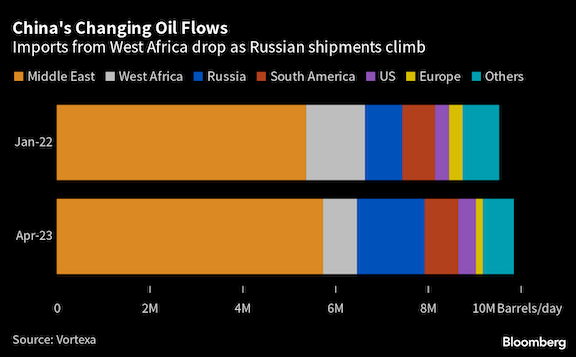Russia is finding oil customers in Asia to replace sanctions-blocked European buyers — by clawing away at the market share of its energy allies.
From West Africa to the Middle East, producers in the OPEC+ alliance are feeling pinched as buyers in India and China — Asia’s top growth markets — scoop up cheaper Russian crude. The redrawn global oil trade map could be in place for years to come.
“There is every reason for the Middle East producers to be worried about losing market share in China and India to Russian barrels,” said Vandana Hari, founder of consultant Vanda Insights in Singapore. “There appears to be no end in sight to the trade flows shift.”
Prices for Russia’s flagship Urals grade plummeted last year as Europe shunned purchases in the fallout of Moscow’s war in Ukraine. Asia’s powerhouses stepped into the void, helping to lift Russia’s seaborne crude exports to a post-invasion record in recent weeks.

India has historically relied on countries like Iraq, Saudi Arabia and the United Arab Emirates to supply the bulk of its crude imports. Now those producers are feeling squeezed.
Since January 2022 — the month before Russia invaded Ukraine — India’s oil imports from the Middle East have plunged by 35% to about 1.9 million barrels a day in April, data from Vortexa Ltd. show. Shipments from West Africa slumped by the same percentage, to 228,000 barrels a day during the period.
Meanwhile, India imported a record 1.9 million barrels a day of Russian crude in April — compared with just 65,000 on a daily basis in January last year. Russia is now vying with the Middle East as the country’s top supplier.
“This is sustainable as long as Russian prices are low,” said R. Ramachandran, former director of refineries at Bharat Petroleum Corp. “There was little demand for Urals in India pre-Russia’s war on Ukraine.”
The price of Urals delivered to India — including shipping costs — was almost $12 a barrel cheaper than the global Dated Brent benchmark on May 15, according to data from Argus Media Ltd. The discount has narrowed by about $5 over the last two months.
China’s Shift
China has continued to receive a steady flow of oil from the Middle East, with shipments even rising slightly since January 2022, according to Vortexa data.
However, Asia’s largest economy has cut its intake of West African crude by more than 40%. Shipments dropped to 730,000 barrels a day in April, from 1.3 million in early 2022. Angola remains by far the region’s largest provider.
At the same time, China’s imports of Russian crude rose by 80% to about 1.5 million barrels a day since early 2022.
Members of the Organization of Petroleum Exporting Countries and their allies aren’t the only ones seeing their share of Asia’s oil market diminish. US flows to India and European shipments to China — which include North Sea grades — have declined.
However, India and China typically rely on the Middle East and West Africa, home to major OPEC+ producers, for the bulk of their crude supply.
A glut of at least 35 million barrels of Nigerian oil due for loading through the end of next month has so far gone unsold, with a lack of Asian buying being a key cause of the buildup, according to traders.
Millions of barrels of West African crude have been stashed in commercial facilities at the Saldanha Bay hub in South Africa this year as Asia buys Russian oil instead, according to the International Energy Agency.
“The deliveries into storage appear to be West African barrels struggling to find buyers East of Suez (due to cheaper Russian crude) while Atlantic Basin refiners undergo maintenance,” it said this week in its latest Oil Market Report.

Follow us on social media: